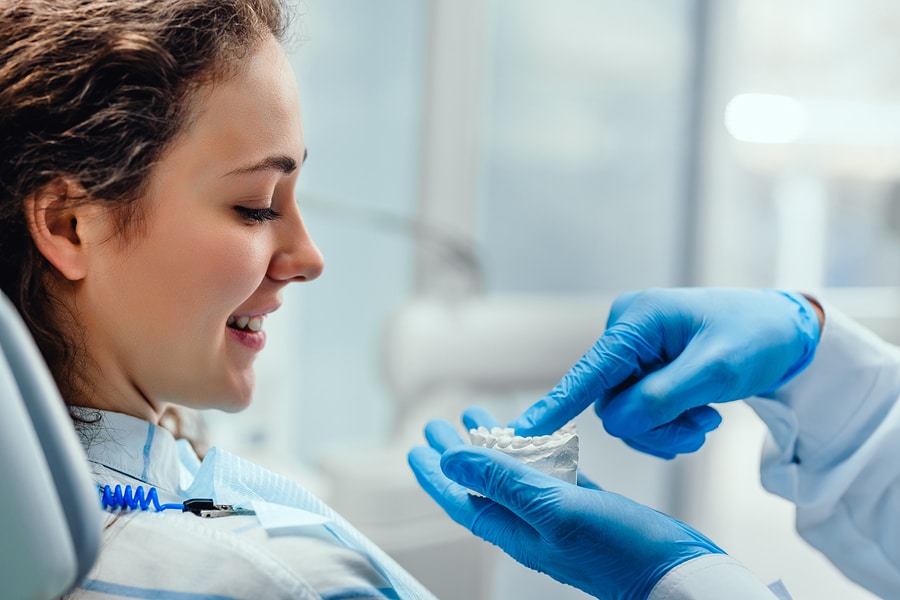New patients have lots of questions when starting treatment – Will I need to wear a retainer afterwards? (Yes, probably.) Do I still have to floss? (Yes, definitely.) Can I still eat taffy? (No!)
Unsurprisingly, some of the most common questions have to do with timing. Many patients want to know when the best time to get braces is and if they can end treatment early. Today we’re going to look more closely at these important questions about timing treatment.
When Is the Best Time to Get Braces?
The answer: It depends.
I know that’s not a helpful answer, but there’s no single answer to this question. It depends on what a patient’s goals are and where they’re starting from.
I will say that it is never too late to improve your smile. Many of my patients are adults, and I’ve put braces on people in their late 70s who have never had orthodontic treatment before. So if you’re older and you’re wondering if you missed the window to get that beautiful smile you’ve always dreamed about, the good news is that you haven’t! You can absolutely still improve your smile.
Having said that, there are some situations where there is a “best” time to undergo treatment for optimal results, and that’s when the patient is younger.
Starting Treatment: When Earlier is Better
A quick rundown on the timeline of how the teeth and jaw develop: Baby teeth grow in between 6 months and 3 years old and then fall out from 6 to 12 years old. Permanent (adult) teeth mostly grow in between 6 and 13 years old (though wisdom teeth come in later, usually between 17 and 21 years). Throughout this time, the upper and lower jaws are still growing and forming.
What does all this mean? It means that for certain types of issues that need correcting, the best time to address them is during this period of childhood and early adolescence. That’s why the American Association of Orthodontists recommends that all children have an initial visit with an orthodontist by age 7. By this age, enough adult teeth have come in, and there has been enough growth of the jaws, for an orthodontist to identify current and potential problems. Then parents can take action to address those problems right away.
Early treatment – also called Phase 1, or interceptive treatment – typically doesn’t address straightening teeth. That happens later, in the teen years, when all the baby teeth have fallen out and the majority of the permanent teeth have already come in. Rather, early treatment is recommended for issues such as severe crowding, a difference in development between the upper and lower jaws, severe protrusion (colloquially called “buck teeth”), and crossbites. In Phase 1 treatment, braces might be used, but other orthodontic treatments are often used, too. These include expanders, headgear, facemasks (aka reverse-pull headgear), and functional appliances.
Some parents might prefer to wait on starting treatment for their little one for a variety of reasons. Maybe they have (incorrectly!) heard that all the baby teeth need to be out before seeing an orthodontist. Maybe they’re concerned about finances. Maybe they believe that any problem can wait to be addressed.
But the truth is that in some cases, early intervention is the key to achieving the best results. Waiting until adolescence or adulthood may mean that treatment ends up being more expensive and involved (e.g., it may require surgery, whereas before the issue could have been addressed with an appliance) and not even produce the same level of results. So while it may seem “out there” to some people to see children as young as 8 or 10 with braces on, know that early intervention is sometimes the best choice for a beautiful, lifelong smile.
When Earlier Isn’t Better: The Pitfalls of Ending Treatment Too Soon
It’s clear there are cases where starting treatment earlier is better, but what about ending treatment a little early? Surely that can’t make a big difference, right? Occasionally, patients want their braces off sooner than we had discussed, often because of an upcoming event, like a graduation or a wedding. In most situations, I advise against this, and here’s why.
Time for another quick anatomy lesson. Teeth are anchored into the jaw bone by periodontal ligaments. Like ligaments in your arms and legs, the ligaments in your mouth are extremely tough yet flexible. As teeth move position, they stretch like a rubber band, exerting forces on the teeth to pull them back to their original position.
It’s the forces on these periodontal ligaments that trigger osteoclasts and osteoblasts, which are special types of bone cells, to do their work. Osteoclasts dissolve sections of the jaw bone that are in the tooth’s way, allowing it to move. Then osteoblasts come along and deposit minerals to secure the tooth into its new spot. This process of creating new bone and making it strong takes several months to complete. So even if your teeth look great, it doesn’t mean they’re “set” in their new position.
Now that you know some of the things going on in your mouth, hopefully you understand why orthodontic treatment takes as long as it does and why getting braces off too early is not smart. If treatment ends too soon, teeth are much more likely to move back towards their starting positions. So you may look great in those graduation or wedding photos, but in time your teeth are likely to drift back, and you might be looking at starting braces all over again.
Talk to Your Orthodontist
I believe that the more information you have, the better. Whether you have an important family event coming up you want to attend braces-free, or you’re concerned about your young child starting treatment, make sure to talk to your orthodontist about it. That way, you can explore all your options and make the decisions that are right for yourself and your family.
=====
Source:

